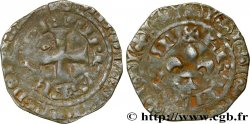bga_295720 - SÉQUANI - HELVETII, Inceri (Svizzera) Quart de statère, au triskèle
non disponibile.
Articolo venduto sul nostro negozio (2013)
Prezzo : 390.00 €
Articolo venduto sul nostro negozio (2013)
Prezzo : 390.00 €
Tipo : Quart de statère, au triskèle
Data: IIe-Ier siècles avant J.-C.
Metallo : oro
Diametro : 13 mm
Asse di coniazione : 9 h.
Peso : 1,96 g.
Grado di rarità : R3
Commenti sullo stato di conservazione:
Rare monnaie bien identifiable et assez bien venue pour ce type souvent fruste
Diritto
Titolatura diritto : ANÉPIGRAPHE.
Descrittivo diritto : Tête laurée à droite, la coiffure en un gros chignon.
Rovescio
Titolatura rovescio : ANÉPIGRAPHE.
Descrittivo rovescio : Cheval galopant à gauche, avec un aurige brandissant un fouet au-dessus de la roue du char ; un triskèle entre les jambes du cheval.
Commento
Mêmes coins que le bga_227417 vendu dans le CELTIC I.
Ce type est excessivement rare et mal connu. D. Allen, dans son article sur les monnaies imitées de Philippe en Suisse et au bord du Rhin, reprend deux exemplaires ; le n° 127 avec une tête à gauche (fruste et mal orienté) et le n° 128 avec la tête à droite (sic).
Le n° 127 auquel correspond notre monnaie, pèse 2 grammes et est conservé à Besançon. Le n° 128 est à Glasgow. Ce type semble manquer, tête à droite ou à gauche, à tous les autres ouvrages de référence sauf à celui de J. Sills qui reprend l’exemplaire de Monnaies et Médailles Bâle, septembre - octobre 1962, n° 31 pour illustrer son n° 335 et l’exemplaire de Glasgow (réorienté en tête à gauche) pour son n° 336.
Il rapproche ce monnayage des monnaies aux lignes entremêlées... pour le groupe gallo-belgic Ba. Il signale que ce monnayage n’a pas d’équivalent et peut être une version simplifié du buste du statère. Le revers dérive du type de Montmorot et est à rapprocher du quart de statère du groupe Helvétique de D. Allen, variété f, avec le triskèle.
D’après le classement de J. Sills, ce quart serait donc un prototype des monnaies aux lignes entremêlées, attribuées aux Calètes (?).
Same corners as the bga_227417 sold in the CELTIC I.
This type is extremely rare and poorly known.. D. Allen, in his article on the imitated coins of Philip in Switzerland and on the banks of the Rhine, includes two examples; No. 127 with a head on the left (rough and poorly oriented) and No. 128 with the head on the right (sic).
No. 127, which corresponds to our coin, weighs 2 grams and is kept in Besançon. No. 128 is in Glasgow. This guy seems to be missing, head to the right or left, from all other reference works except J's. Sills, who uses the copy of Monnaies et Médailles Bâle, September - October 1962, no. 31 to illustrate his no. 335 and the copy from Glasgow (reoriented with the head on the left) for his no. 336.
He compares this coinage to coins with intertwined lines. . . for the Gallo-Belgian group Ba. He points out that this coinage has no equivalent and may be a simplified version of the bust of the stater. The reverse derives from the Montmorot type and is similar to the quarter stater of the Helvetic group of D. Allen, variety f, with the triskelion.
According to J's ranking. Sills, this quarter would therefore be a prototype of the coins with intertwined lines, attributed to the Caletes (?)
Ce type est excessivement rare et mal connu. D. Allen, dans son article sur les monnaies imitées de Philippe en Suisse et au bord du Rhin, reprend deux exemplaires ; le n° 127 avec une tête à gauche (fruste et mal orienté) et le n° 128 avec la tête à droite (sic).
Le n° 127 auquel correspond notre monnaie, pèse 2 grammes et est conservé à Besançon. Le n° 128 est à Glasgow. Ce type semble manquer, tête à droite ou à gauche, à tous les autres ouvrages de référence sauf à celui de J. Sills qui reprend l’exemplaire de Monnaies et Médailles Bâle, septembre - octobre 1962, n° 31 pour illustrer son n° 335 et l’exemplaire de Glasgow (réorienté en tête à gauche) pour son n° 336.
Il rapproche ce monnayage des monnaies aux lignes entremêlées... pour le groupe gallo-belgic Ba. Il signale que ce monnayage n’a pas d’équivalent et peut être une version simplifié du buste du statère. Le revers dérive du type de Montmorot et est à rapprocher du quart de statère du groupe Helvétique de D. Allen, variété f, avec le triskèle.
D’après le classement de J. Sills, ce quart serait donc un prototype des monnaies aux lignes entremêlées, attribuées aux Calètes (?).
Same corners as the bga_227417 sold in the CELTIC I.
This type is extremely rare and poorly known.. D. Allen, in his article on the imitated coins of Philip in Switzerland and on the banks of the Rhine, includes two examples; No. 127 with a head on the left (rough and poorly oriented) and No. 128 with the head on the right (sic).
No. 127, which corresponds to our coin, weighs 2 grams and is kept in Besançon. No. 128 is in Glasgow. This guy seems to be missing, head to the right or left, from all other reference works except J's. Sills, who uses the copy of Monnaies et Médailles Bâle, September - October 1962, no. 31 to illustrate his no. 335 and the copy from Glasgow (reoriented with the head on the left) for his no. 336.
He compares this coinage to coins with intertwined lines. . . for the Gallo-Belgian group Ba. He points out that this coinage has no equivalent and may be a simplified version of the bust of the stater. The reverse derives from the Montmorot type and is similar to the quarter stater of the Helvetic group of D. Allen, variety f, with the triskelion.
According to J's ranking. Sills, this quarter would therefore be a prototype of the coins with intertwined lines, attributed to the Caletes (?)








 Segnalare un errore
Segnalare un errore Stampate la pagina
Stampate la pagina Condividi mia selezione
Condividi mia selezione Fai una domanda
Fai una domanda Consegnare / vendere
Consegnare / vendere
 Descrittivo
Descrittivo















